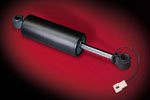 UK newspaper The Guardian recently ran a fascinating story about cunning plans to capture wasted energy, for example the impact energy of commuters walking across a railway station concourse is estimated to peak in the kilowatts. Not much to do with cars, obviously, but the article goes on to note that dampers used to halt the swaying of bridges could capture the energy they absorb, rather than simply allowing it to warm up the dampers.
UK newspaper The Guardian recently ran a fascinating story about cunning plans to capture wasted energy, for example the impact energy of commuters walking across a railway station concourse is estimated to peak in the kilowatts. Not much to do with cars, obviously, but the article goes on to note that dampers used to halt the swaying of bridges could capture the energy they absorb, rather than simply allowing it to warm up the dampers.
This set us thinking. Hybrids like Toyota's Prius and electric noddy cars like the G-Wiz make a point of using regenerative braking - essentially using the resistance of a dynamo to slow the car, turning the unwanted kinetic energy into electricity rather than allowing a simple disc or drum brake to translate momentum into waste heat.
These eco-friendly, efficiency-obsessed cars are clearly missing a trick. The reciprocating motion of wheels bouncing up and down over the potholes that pockmark the average patch of UK asphalt is clearly an untapped mine of energy. Wheels do tend to travel up and down, and energy has be removed from the system to prevent nauseating bounciness – not to mention the loss of control that results when a wheel bounces right off the road. Dampers do that job, typically by forcing a viscous oil to pass through a constriction inside the damper tube. Viscosity is the fluid equivalent of friction, so the dampers effectively turn motion into waste heat, just as brakes do.
Clearly the amount of energy involved is very different – as witness the fact that dampers are seldom fitted with fins to aid their cooling, whereas discs are often cross-drilled, slotted or vented. However, the energy involved cannot be negligible.
Current state-of-the-art active dampers employ a fluid suffused with magnetic particles to allow the viscosity to be computer controlled, so they are already wired up to the vehicle. One wonders if the movement of the same magnetic fluid might conceivably be inverted to generate a little extra juice.
skip to main |
skip to sidebar
Most Popular
-
Mercedes-Benz C 220 CDI review – Executive SE edition
-
Rising star: Mercedes C220 BlueTec review
-
Renault Scenic versus Citroen C4 Picasso
-
Lexus GS 450h review
-
Mild-mannered hybrid: Kia Sportage 48V driven
-
Facelifted Golf GTD is both better and worse
-
Volkswagen e-Golf versus BMW i3
-
Audi A1 and A3 to get half an engine
Browse by Brand
Most Recent
 © 2005 to GreenMotor.co.uk | Contact | Terms & Conditions | Cookies | Privacy | Powered by
© 2005 to GreenMotor.co.uk | Contact | Terms & Conditions | Cookies | Privacy | Powered by  | Close
| Close

